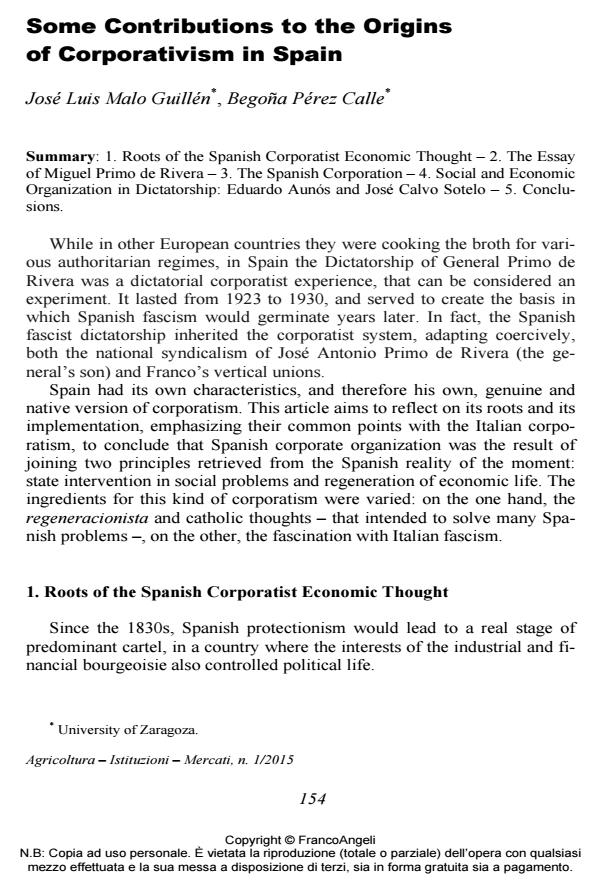Some Contributions to the Origins of Corporativism in Spain
Journal title AGRICOLTURA ISTITUZIONI MERCATI
Author/s José Luis Malo Guillén, Begoña Pérez Calle
Publishing Year 2017 Issue 2015/1
Language English Pages 16 P. 154-169 File size 196 KB
DOI 10.3280/AIM2015-001008
DOI is like a bar code for intellectual property: to have more infomation
click here
Below, you can see the article first page
If you want to buy this article in PDF format, you can do it, following the instructions to buy download credits

FrancoAngeli is member of Publishers International Linking Association, Inc (PILA), a not-for-profit association which run the CrossRef service enabling links to and from online scholarly content.
It’s always been understood that the first corporatism in Spain was the result of the different economic and political forces, besides the different interests of that bourgeoisie. But there were really three ingredients in economic thought that played a main role: neogremialismo, regeneracionista speech and social catholicism. By these means, the first essay of the corporativism in 1923 can be interpreted as an autoctonous process and not as the Spanish version the fascism of our Italian neighbours. The answer to the country’s situation in thought and social reality, coupled with the influence of the prevailing philosophy in the Italian system, facilitated the entry to the first corporatist regime. This brief dictatorial experience helped to cook the broth where Spanish fascism would germinate years later, and to analyze the mean inputs in the gestation of this thought is of great importance. So, we can understand that Spanish corporate organization was the result of joining two principles: state intervention in social problems and regeneration of economic life. Two principles extracted from the Spanish reality of the moment.
Keywords: Corporativism, Fascism, Regeneracionismo, Social Catholicism, Primo de Rivera Dictatorship.
- Amoroso L. (1938), Principi di economia corporativa, Zanichelli, Bologna.
- Aunós E (1930), Estudios de derecho corporativo, Editorial Reus, Madrid, 1st ed.
- Aunós E (1935), La reforma corporativa del Estado, M. Aguilar, Madrid, 1st ed.
- Aunós E. (1928a), «La Organización Corporativa Nacional del trabajo. Sus principios fundamentales», Revista Social, 1.
- Aunós E. (1928b), El Estado corporativo, Ministerio de Trabajo, 1st ed.
- Aunós, E. (1944), La política social de la Dictadura. Discurso de recepción en la Racmp el 23 de mayo de 1944, Real Academia de Ciencias Morales y Políticas, Madrid.
- Aznar S. (1946), Estudios Económico-Sociales, Instituto de Estudios Políticos, Madrid.
- Aznar S. (1950), Impresiones de un Demócrata Cristiano, Bibliográfica española, Madrid.
- Cabrera Calvo-Sotelo M., Del Rey F. (2002), El poder de los empresarios, Santillana, Madrid.
- Calvo Sotelo J. (1938), El capitalismo contemporáneo y su evolución, Cultura Española, Valladolid.
- Calvo Sotelo J. (1974): Mis servicios al Estado. Seis años de gestión, Instituto de Estudios de Administración Local, Madrid (first edition 1931, Imprenta clásica española, Madrid).
- Cambó F. (1921), Elementos para el estudio del problema ferroviario en España, Ministerio de Fomento, Madrid, 6 vols.
- Faucci R. (a cura di) (1990a), «Il pensiero economico italiano tra le due guerre», Quaderni di storia dell’economia politica, VIII, 2-3.
- Fovel N.M. (1929), Economia e corporativismo, Sate, Ferrara.
- Fraile P. (1998), La retórica contra la competencia en España (1875-1975), Funda ción Argentaria, Madrid.
- Gil Cremades J.J. (1969), El reformismo español, Ariel. Barcelona.
- González Ruiz N. (1948), Sánchez de Toca, Ed. Purcalla. Madrid.
- Ice (1961), «Joaquín Costa, Regeneracionista Español», Información Comercial Española, diciembre.
- Jover J.M., Gómez-Ferrer G., Fusi, J.P. (2001), España: Sociedad, política y civilización (siglos XIX-XX), Debate, Madrid.
- López Coira M. (1986), El pensamiento social de Severino Aznar, Universidad Complutense, Madrid.
- Malo J.L. (2005), El krausismo económico español. Real Academia de Ciencias Morales y Políticas, Madrid.
- Manoilesco M. (1935), Le siécle du corporatisme, Nouvelle Editions, París.
- Mussolini B. (1938), El Estado Corporativo, U.S.I, Salamanca.
- Perdices L. (2003), Historia del pensamiento económico, Síntesis, Madrid.
- Pérez Pujol E. (1889), «Prólogo», in Tramoyeres L., Instituciones gremiales: su origen y organización en Valencia. Imprenta Domenech, Valencia.
- Perfecto M.A. (1982a), Orígenes y Evolución de la idea corporativista en Europa. Su influencia en el esquema teórico del corporativismo primorriverista (1926-1930), Tesis doctoral, Universidad de Salamanca, mímeo.
- Perfecto M.A. (1982b), «Introducción al pensamiento político y económico-social de Eduardo Pérez Pujol», Revista Provincia de Salamanca, 3, May-June.
- Perfecto M.A. (2006), «Pasado y Memoria», in Revista de Historia Contem poránea, 5.
- Primo de Rivera M. (1930), Intervenciones en la Asamblea Nacional, Imprenta Sáez Hermanos, Madrid.
- Romeu S. (1979), Eduardo Pérez Pujol. Vida y obra. Reedición de 15 trabajos y prólogos de Pérez Pujol, Artes Gráficas Soler, Valencia.
- Sánchez de Toca J. (1917), El petróleo como artículo de primera necesidad para nuestra economía nacional, Imprenta de Isidoro Perales, Madrid.
- Sánchez Hormigo A. (2008), «La pluralidad programática de las derechas», in Fuentes Quintana E. (dir.), Comín F. (coord.), Economía y economistas espa ñoles en la guerra civil, Galaxia Gutenberg-Real Academia de Ciencias Mora les y Políticas, Barcelona, vol. II.
- Sanz y Escartín E. (1894), Las asociaciones obreras y el catolicismo. Discurso leído en el Congreso de Tarragona, Hijos de J.A. García, Madrid.
- Velarde J. (1973), Política económica de la Dictadura, Biblioteca Universitaria Guadiana, Madrid.
- Vito F. (1941), Las Uniones de empresas en la economía fascista (Sindicatos industriales, consorcios y grupos, Bosch, Barcelona.
José Luis Malo Guillén, Begoña Pérez Calle, Some Contributions to the Origins of Corporativism in Spain in "AGRICOLTURA ISTITUZIONI MERCATI " 1/2015, pp 154-169, DOI: 10.3280/AIM2015-001008